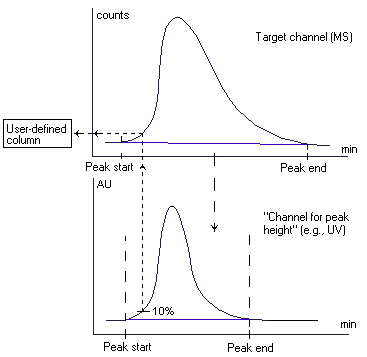Collecting Fractions Automatically (Autopurification)
![]() Using Optimized MS Threshold Values
Using Optimized MS Threshold Values
The Purification Sample Wizard supports the input of automatically optimizing threshold values for peak detection. For example, this may be useful in the following situation:
When the ion source of the Mass Spectrometer is overloaded, it may appear in the MS channel as if a target compound is still eluting from the column. To avoid collecting fractions that do not contain the target compound, you can enter two automatically optimizing MS threshold values for the peak start and peak end on the Optimized MS Threshold TCx page. Follow the steps below:
From the Channel for peak height list, select the channel to be used to determine the retention time at the peak height specified in the Peak Front Evaluation and Peak End Evaluation sections. From the Signal evaluation channel list, select the channel whose signal height at this retention time is used. The target channel is the default setting, but you may select a different channel, instead. In addition, you may enter a Multiplication Factor. The signal value of this channel is multiplied with this factor.

In the example, the ion source is overloaded, resulting in tailing of the peak on the MS channel (contrary to the peak in the UV channel). To check whether the peak exists on the UV channel, Chromeleon first determines the retention time that is exactly between the peak start and peak end on the MS channel. This retention time is also between the peak start and peak end on the UV channel (dashed lines), thus proving that the peak exists on the UV channel, too.
Afterward, Chromeleon determines the retention time at which the signal on the UV channel has reached (in this example) 10% of the maximum on the ascending peak edge (dotted line). Finally, Chromeleon determines the height of the signal on the Signal evaluation channel at this retention time. In the example, the signal evaluation channel is the target channel.
In the pre-analysis (i.e., during the analysis of the sample for which the Auto Purif. Type is Analytic), the signal value is written to the specified User-defined Column and evaluated during fraction collection (i.e., during the analysis of the sample for which the Auto Purif. Type is Preparation). When the signal value is exceeded during the analysis of the preparation-type sample, a peak is detected and a fraction is collected.
To determine the peak end and thus stop fraction collection, you can enter the height for Peak Tail Evaluation in the same way.
![]() Tip:
Tip:
Samples consisting of several substances with clearly different degrees of ionization are another example. When a fixed threshold value is used, it is possible that only a small portion (or no portion) of weakly ionizing substances might be collected. However, with an optimized MS threshold, the same portion of substances would be collected even if the ionization degrees were different.